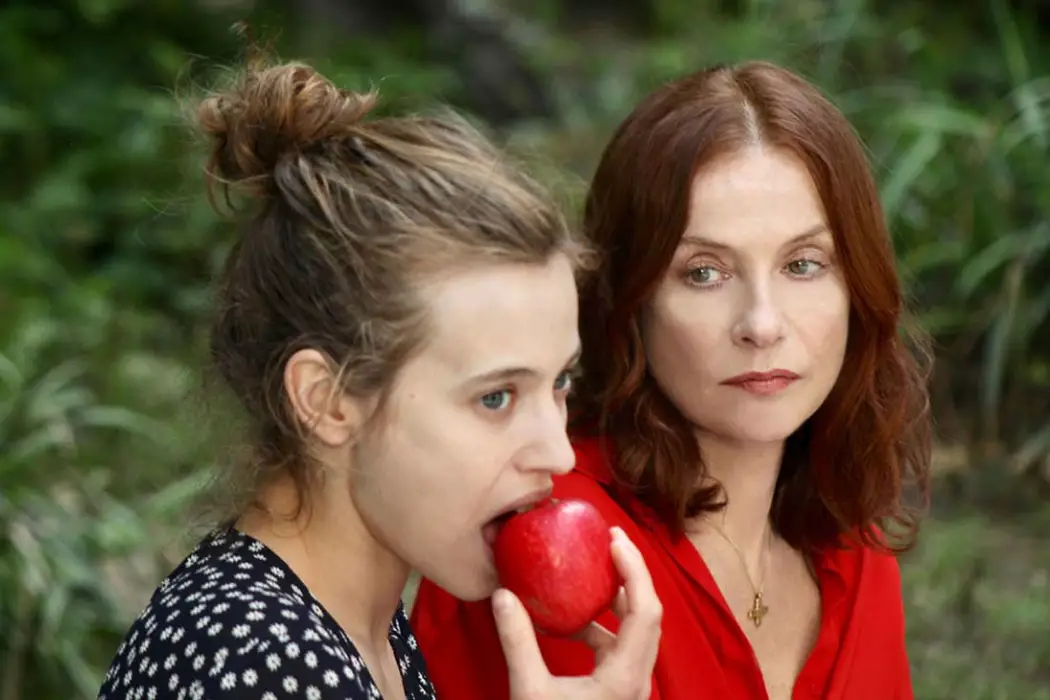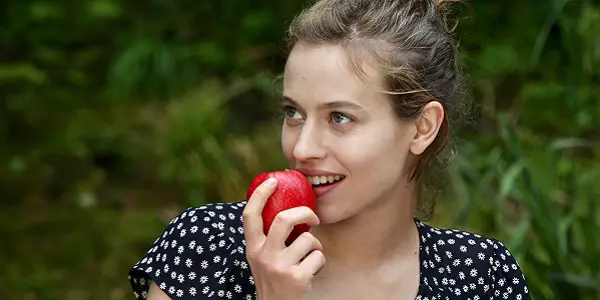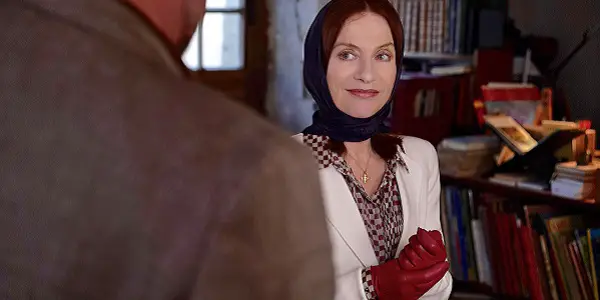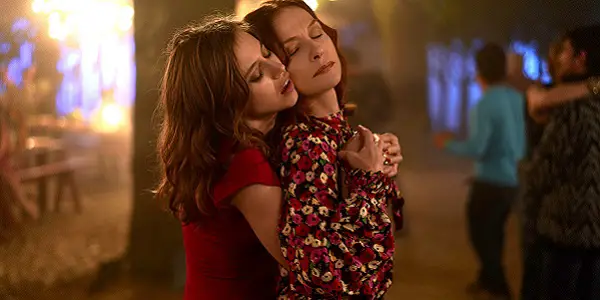WHITE AS SNOW: A Particularly Fractured Fairy Tale

Lee Jutton has directed short films starring a killer toaster,…
The latest film from writer-director Anne Fontaine (The Innocents, Gemma Bovery) is a new take on an old legend: that of Snow White and the Seven Dwarfs. White as Snow reinterprets the fairy-tale first made famous by the Brothers Grimm to chronicle one young woman’s sexual awakening after she escapes the clutches of her icy stepmother. With the iconic Isabelle Huppert playing said stepmother, you know this isn’t going to be your great-grandmother’s Snow White (or Walt Disney’s either, for that matter). Instead, it’s a gorgeously lensed tale of female emancipation and generational jealousy.
Heigh-Ho
Claire (Lou de Laâge) is a quiet young woman working in the family hotel under the watchful eye of her imperious stepmother, Maud (Huppert). One day, Maud suggests to her lover, Bernard (Charles Berling), that they take a break from their relationship. Yet where Maud’s passion has been extinguished, her jealousy is quickly ignited when she overhears Bernard immediately call and profess his love to Claire. You can guess what happens next: broken-hearted, and unable to accept that she is no longer the fairest of them all, Maud hires a killer (Agata Burzek) to dispatch her beautiful stepdaughter.
Unfortunately for Maud, the attempt on Claire’s life goes awry, and Claire is able to escape into the forest surrounding a small French mountain town. Here, she is rescued and taken in by a set of twin brothers (both played by Damien Bonnard) and their eccentric cellist roommate (Vincent Macaigne). It quickly becomes clear that almost everyone in this remote town is hiding from something, whether it be the law, a previous relationship, or even pollution (in the case of the aforementioned eccentric cellist).

Claire immediately takes to her new surroundings, discovering and embracing a liberated sensuality she didn’t know she had in her. She first sleeps with one twin, then the other, and soon is surrounded by a small circle of—you guessed it—seven adoring male admirers. Not all of them are romantically involved with her; one of them is the sympathetic local priest (Richard Fréchette), who rides a motorcycle and sees no problem with Claire’s sexual escapades as long as she’s not harming anyone. (The local veterinarian Claire sleeps with one night who becomes almost fanatically jealous of every other man in town afterward might disagree.) Yet Claire’s joyous new existence is threatened by Maud, who still wants to get rid of her once and for all.
Someday My Prince(s) Will Come
Fontaine leans into the fairy-tale roots of her story from the opening frames, relying on audience familiarity with certain tropes and symbols in order to take narrative short-cuts while also twisting those elements to suit her particular purposes. The film is structured in three chapters: the first focused on Claire, the second on Maud, and the third on what happens when the two of them are reunited in the village. The beautiful forest landscape that surrounds Claire and magically unlocks her ability to desire includes the usual charming woodland creatures, though here they are more inclined to spy on Claire having sex in a car than to sing along with her while she does her chores.
The film looks as magnificent as an illuminated manuscript courtesy of cinematographer Yves Angelo. Claire is often described by other characters in the film with all of the adjectives that one would expect to hear applied to a fairy-tale princess on the page; in one scene, the priest describes her as being surrounded by a halo, while in another, Maud notes that her new lifestyle has her skin glowing, making her more lovely than ever before. Obviously, de Laâge, with her clear pale skin and full red lips, is naturally beautiful, but these remarks would still feel hyperbolic if she were not lit and shot in such a way as to make them absolutely true. There are also numerous excellent shots of Huppert in silhouette that render her both ominous and intriguing—especially with her tendency for intense vaping, smoke curling from her lips like a dragon patiently waiting its chance to lunge at its prey.

The color red abounds in White as Snow, from the fitted red suit and matching lipstick that Maud is wearing the first time we see her (examining her appearance in a mirror before demanding that Claire get Pink Lady apples for a fruit platter at the hotel), to the luscious red apples that Maud injects with poison ahead of a picnic with Claire, to the slinky red dress that Claire wears during the film’s climactic scene, dancing with wild abandon while Maud looks on with both admiration and jealousy. That Maud begins the film in red while Claire ends it clad in the color is a visual signifier that what Maud has feared has indeed come to pass: her stepdaughter has surpassed her in desirability.
Personally, I disagree with the notion that Isabelle Huppert at age 68 is any less beautiful or magnetic than Lou de Laâge at age 31, which is probably one of the reasons why the film’s story didn’t quite resonate with me. While the acting and the visuals are all stellar, the script is somewhat lacking. The characters of both the lovely young “princess” and her wicked stepmother are very roughly sketched out, relying on the (quite substantial) natural charisma of the two leads in order to keep you engaged. Yet the motivations of both women are hard to understand throughout due to various abrupt changes in mood, such as Maud going from being simply broken-hearted that her lover is interested in Claire to be willing to murder her just because a woman working at a strange clinic she attends suggests it.
While Claire’s sudden transformation from a shy and reserved young woman to an earthy sex goddess is more easily explained away by her change in surroundings—she literally and figuratively experiences an awakening in the forest away from her strict stepmother—it still requires some suspension of disbelief. Which is fine—this is a fairy tale, after all—but audience members who aren’t content to simply watch de Laâge disrobe again and again will likely be left wanting something more from White as Snow. One of the final scenes between the two women—a shared dance in which Maud appears to desire Claire just as much as she wants to destroy her, whipping her body around like a rag doll before pulling her into a tight embrace, over and over again—is also one of the best, and tells us more about the complex nature of their relationship than anything else that happened in the film previously. (Plus, who doesn’t want to see Isabelle Huppert dance?)

As for the seven dwarfs-slash-princes, they all bring something different to the story and to their relationships with Claire. I was particularly fond of Fréchette as the wise and kindly priest and Macaigne as the hypochondriac cellist who is more interested in playing music with Claire than sleeping with her (too many germs, you know). But the real standout is Benoît Poelvoorde as Charles, the scratchy-voiced local bookseller who waxes rhapsodic about Claire’s beauty while also begging her to punish him with a whip hidden amongst the bookshelves. He’s a bizarre character, but Poelvoorde’s unique comic talents make his scenes by far the funniest in a movie that purports to be a dark comedy but doesn’t actually elicit many laughs.
Conclusion
One can appreciate White as Snow as a visually stunning tale of female empowerment and nonconformity while also wishing it delved deeper into characters that are little more than fairy-tale archetypes.
What do you think? What’s your favorite fairy-tale movie? Share your thoughts in the comments below.
White as Snow is released in theaters in the U.S. on August 13, 2021.
Does content like this matter to you?
Become a Member and support film journalism. Unlock access to all of Film Inquiry`s great articles. Join a community of like-minded readers who are passionate about cinema - get access to our private members Network, give back to independent filmmakers, and more.
Lee Jutton has directed short films starring a killer toaster, a killer Christmas tree, and a not-killer leopard. Her writing has appeared in publications such as Film School Rejects, Bitch: A Feminist Response to Pop Culture, Bitch Flicks, TV Fanatic, and Just Press Play. When not watching, making, or writing about films, she can usually be found on Twitter obsessing over soccer, BTS, and her cat.












